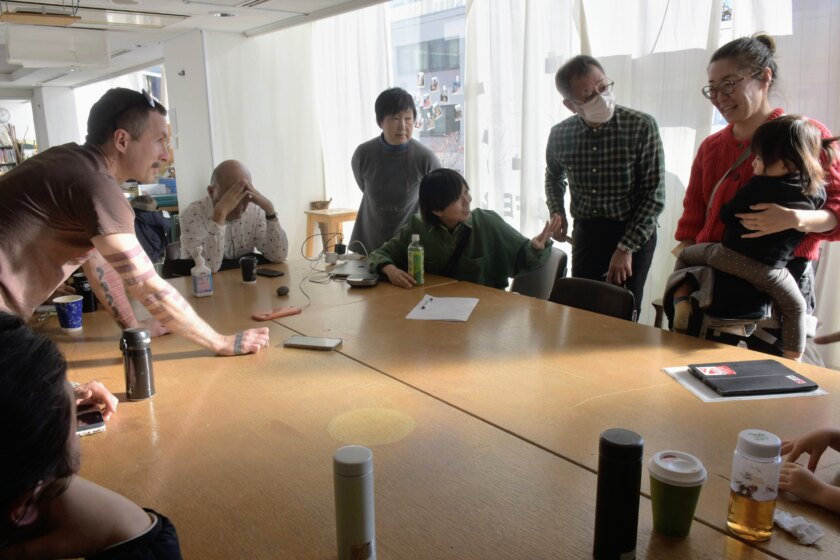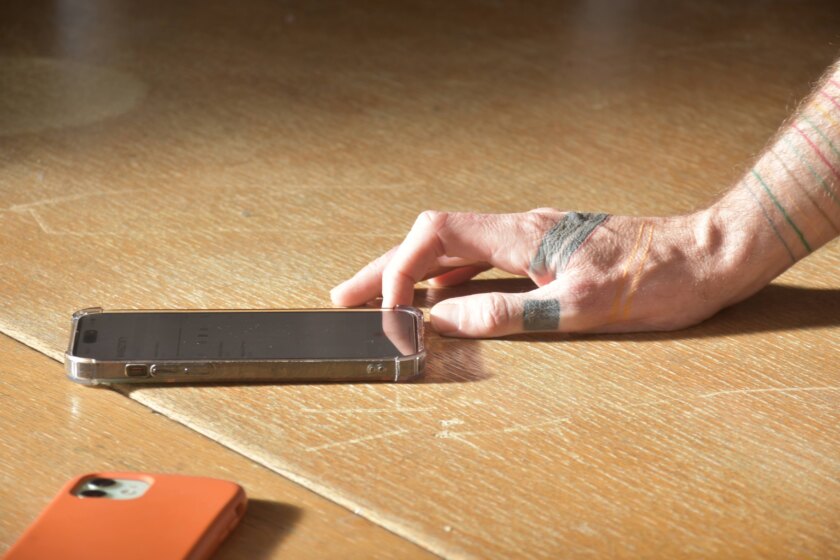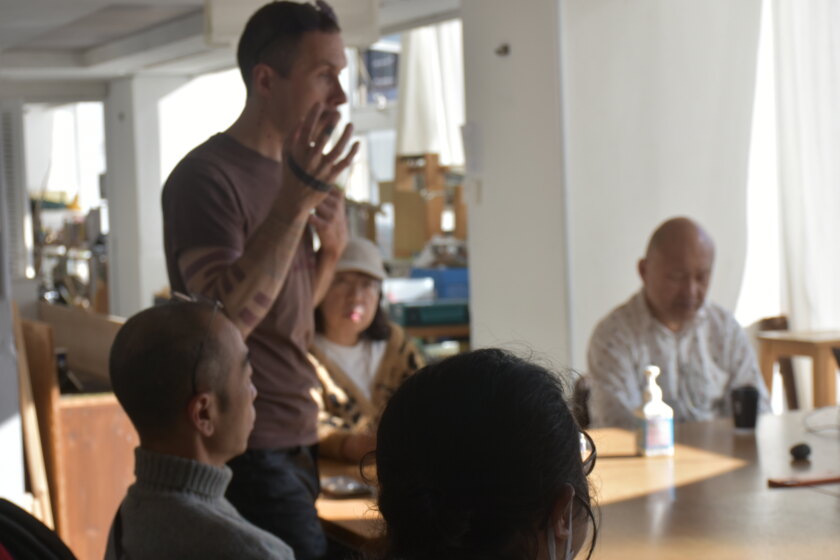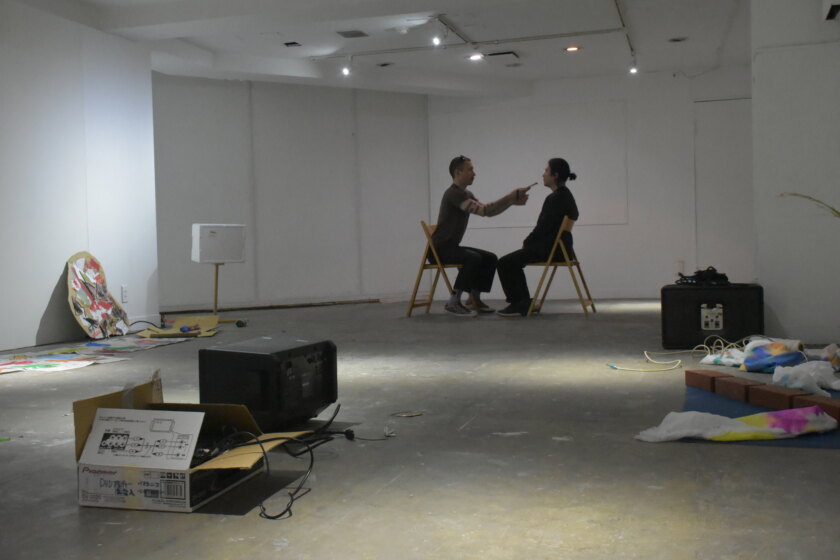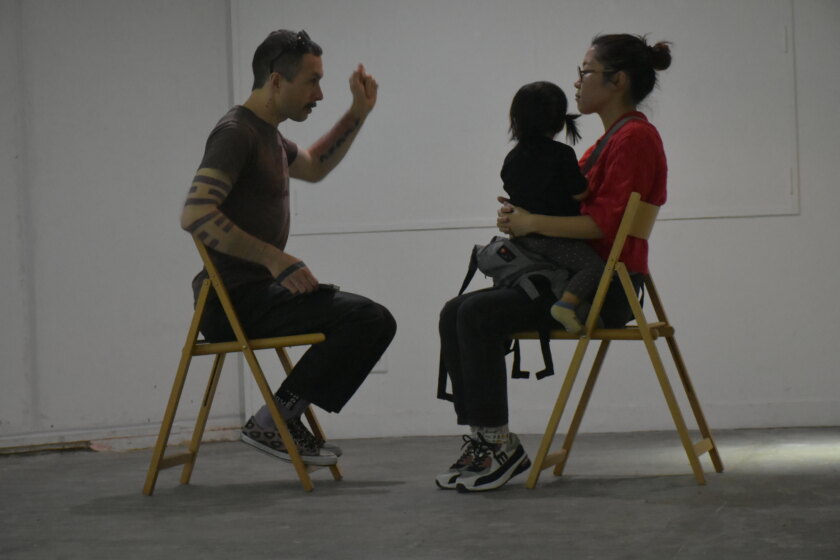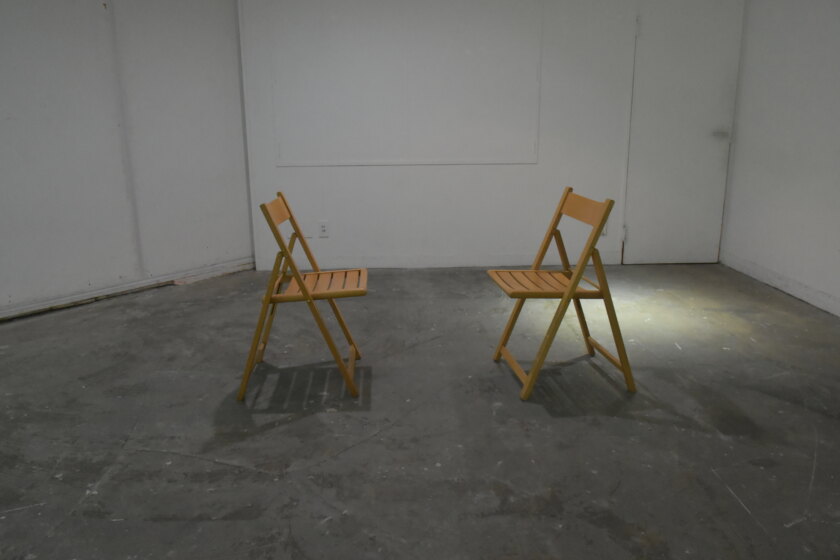<Currents>
This workshop, focused on the phenomenon of human breathing, will be dedicated to designing a collective audio piece where each of participants will become an instrument or perhaps a sound vessel and will be asked to have recorded the sound of one’s breathing.Depending on the character and the dynamic of the cohort, there shall be a several scenarios of this process, in order to produce and secure enough of as much diversified material as possible.Ideally this project will be targeting such theme as unspoken experimental storytelling, body memory, unconsciousness and balance.
<Currents>
このワークショップでは、人間の呼吸の現象に焦点を当て、参加者それぞれが楽器、あるいは音の器となり、自身の呼吸音を録音し、そこから集団的なオーディオ作品をデザインしてみます。参加者のキャラクターや動向に応じていくつかのアプローチやプロセスを想定し、できる限り多様な素材を集めることを目標としています。このプロジェクトでは言葉にならない実験的な語り、身体の記憶、無意識、バランスなどに着目しています。
手順:
1. カフェスペース(待機場所)からギャラリー(録音場所)へ移動。ギャラリーの真ん中に向かい合わせで椅子が2脚置かれている。
2. 片方の椅子に座って目を閉じ、緑について考えながら呼吸をする。*その間、もう片方の椅子にPioが座り、iphoneで呼吸音を録音する。
3. カフェスペースに戻り、録音された呼吸を聞きながらディスカッションをする。
4. 再度ギャラリーへ移動。
5. 片方の椅子に座って目を閉じ、今度は赤に緑が侵食されるのを想像しながら、呼吸をする。*その間、もう片方の椅子にPioが座り、iphoneで呼吸音を録音する。
6. カフェスペースに戻り、録音された呼吸を聞きながらディスカッションをする。
ピョトル・ブヤクのステートメントより
================
*ピョトル=Pio
*当日ピョトルは英語で参加者へ語り、必要に応じて通訳が行われました。その場のやりとりのリズム感や雰囲気を重視した内容になっています。会話の中の翻訳部分は《 》で示されています。
◉最初に
最初にピヨからこのワークについての説明がありました。
Pio | My name is Pio. Only Pio, ‘san’…no. I’m an anarchist, and I try not to use the san, sama or other honorific suffixes. I refuse hierarchy. The goal of this whole program is to address the notion of protest, as well as the idea of resistance against the system, and the system itself is based on hierarchy. In this project, I will refer to my own methodology, which is very much low budget, DIY, hit and run and quick and dirty, which are very improvised methodologies, and often uses just the material that is in very close proximity.
《 私の名前はPio。Pioだけで。さん、様、その他の敬称は使わないで欲しい。私はアナーキストで、ヒエラルキーを拒絶している。このプロジェクトの目標は、抗議の概念と、システムへの抵抗に取り組むことで、システムはヒエラルキーに基づいている。今回は、私自身の手法である「低予算、素早く雑に、DIYで、打って走る(Low Budget, Quick and Dirty, Do It Yourself and Hit and Run)」のアプローチを参照しながら取り組んでいく。とても即興的な手法であり、主に身近にある素材を活用する。》
The idea for this workshop is not really to teach you to produce anything. The thing that I care about the most, is how, in the process of the workshop environment, by practising contemporary art we can change the way we think and the way you see the world.
《このワークショップは、何かを作る方法を教えるものではなく、ワークショップ環境の中での現代アートの実践を通じて、自身の考え方や世界を見る方法をいかに変えれるのか、というところを私は重視している。》
I have been long thinking, what is the most primal, most basic manifestation of your protest? I came to the conclusion that it is just your presence. Yourself, either as an individual, or you as a huge crowd, being present in a given place for a given reason, is often enough for the protest, especially for the protest in the public space.Then I thought what is the simplest way of showing the presence, and also what – conceptually wise – is the manifestation of human presence?
《私は長い間、抗議を表す最も本質的で基本的なものについて考え、それは私たちの存在そのものなのでは、という結論に達しました。個として、また大衆として、ある理由の元特定の場所に存在すること。それは抗議、特に公共空間での抗議の場合、十分なのではないかと。そこから私は存在を示す最も簡単な方法は何か、そして概念的な観点も含んだ、人間の存在を明示するものは何かということを考えはじめた。》
I figured the simplest form of manifesting your existence is just breathing. I mean, we breathe, just as we exist. So then the idea of breathing became the core for this workshop and for the project of mine.
《自身の存在を明示する最も簡単な方法は、単に呼吸することだと思いついた。つまり、私たちは呼吸をし、存在する。この呼吸のアイデアが、今回のワークショップと私のプロジェクトの核となっていった。》
So, today we will start working, in an entirely abstract way. The really important component is that I will record you with an iphone. I find it more appropriate for the idea of mass protest, improvisation or emotion, to be recorded with the tools that are mundane and casual. And after each recording, after each single time, we’ll come back here and play the recording to hear it out and have a short discussion to see whether it has triggered anything in your mind. And you know, over and over again.
《ということで、今日はとても抽象的な方法でワークを行う。今回はiPhoneで録音を行うが、これも大切な要素の一つだ。抗議の文脈や即興性を考慮し、また、感情を録音するにあたり、ありふれた日常的なツールを使用するのがいいと考えた。各録音後は、ここ(カフェスペース)に戻って音を再生し、セッション中にどのような感情の揺れがあったかを聞くために、簡単なディスカッションの時間を設ける。これの繰り返しです。》
◉ 作業中の参加者とピヨの会話
録音された呼吸音を皆で聞きながら行われたディスカッションや、ピヨと1人の参加者が録音中にカフェスペースで交わされた他の参加者たちの会話を抜粋しました。
ーー前半、緑を思い浮かべながらの録音
参加者|純粋な色そのものを想像するというよりは、やっぱりビジュアル的に想像しちゃうことがあって。純粋な色だけ思い浮かべるべきなのか、色に関連したものとかが思い浮かんできてもOKなのかよくわからない。もし指定があったらお願いします。
《Rather than imagining the pure colour itself, I still imagine it visually. I’m a little unsure whether I should only think of the pure colour, or whether it is ok to think of something related to the colour. If you have a specification, please do.》
Pio|I mean, I cannot answer this question. My goal is to give you a hint, which is just this green colour. How you think about green, it’s up to you. I’m giving you just like the very most necessary information. I’m really glad that you asked this question, because the part when you ‘think’ is actually the most important part of your creativity.
《その質問に答えることはできない。私の目標はあなたにヒントを与えることであり、そのヒントは「緑色」のみです。緑についてどのように考えるかはあなた次第。私は必要最低限の情報だけを提供します。あなたがこの質問をしてくれたことが本当に嬉しい。「考える」部分があなたの創造性において最も重要な部分なのでね。》
ーーーーー
参加者1|自分で呼吸音を録音したことあるんですが、とられていることを意識すると、自然に呼吸するのは難しいよね。
《I’ve recorded the sound of my breathing before, but it was hard to breathe naturally when you’re aware that you’re being recorded.》
参加者2|どの人も同じく呼吸してるんですけども、呼吸の仕方で、年齢が出るというか、純粋かどうかの差を感じますね。呼吸しようとしている感じと、普通な感じと。
《Everyone is breathing, but the way they breathe shows the age, and purity of your mind, I think. There’s a difference between trying to breathe and breathing just naturally.》
参加者3|僕は2回録音して、音が入らなかったから、最低限音を入れなければという気持ちが多分あって、深呼吸したら入るかなとか、口を大きく開けた方が入るかなとか、そういう細かいことを考えていたので、やってる感じの呼吸になったかな。自分の不自然な呼吸音が恥ずかしい。
《I recorded two times and the sound didn’t register well, so I probably felt that I had to at least ‘try’ to get it in. So I was thinking about the details of breathing, like whether it would go in if I took a deep breath or if it would go in if I opened my mouth. So my breathing sounds unnatural. I am embarrassed with my unnatural breathing.》
Pio | That also highlights how thinking changes in a given setups.
《特定の状況下において、思考がどう変化するかがわかるね。》
参加者2|呼吸って個人的なことですよね、結構。
《breathing is quite private》
参加者1|人間の、大げさに言うと人間力が出てるような気がする。
《It’s a bit of an exaggeration, but I think a person’s humanity comes out in the way they breathe.》
ーーーーー
ーー後半、赤を思い浮かべながらの録音
Pio | Now, it’s the time for red. That green part was important because it was kind of like a reason for the red part. What I would like to ask you now is, keep in mind the idea of red, try to imagine all of those things that you thought about while thinking about green being destroyed. Red, right? The idea of danger but built on the idea of the green that we have just worked with.
《さて、赤の時間です。緑の部分は、この赤のターンを行うために必要でした。今度は、赤について思い浮かべながら、先ほど緑から想像したイメージが破壊される様子を想像してみてください。赤です。危険などのイメージがあると思いますが、今回は先ほど緑について思い浮かべたイメージに基づいて、頭の中に赤をイメージしてみてください。》
ーーーーー
Pio | I think red gives you this feeling of danger, or something stressful coming. Compared to green, did you feel that kind of stress?
《おそらく赤は危機感とか、重圧のようなものを感じたのではないかと。緑に比べて、そのようなストレスは感じた?》
参加者1|最初の緑の時の方がストレスを感じていました。1回目で、最初だったので。
《I felt more stress in the green part, since it was my first go, and I was the first one.》
参加者2|この場合は、色が赤とか緑とか関係ないんじゃないですか?緑の方がストレスを感じた、ということなので。
《In this case, it doesn’t matter if the colour is red or green, does it? Since he felt more stress in the green part.》
Pio | It doesn’t work this way. I have already mentioned the idea of green to you. The mind is already set up for the green. So, even if it seems that it doesn’t make a difference, it is different. It’s kind of superficial that it doesn’t make a difference.
《そうはいかないんです。私はすでにグリーンについてあなたに伝えた。意識には緑がすでに刷り込まれている。だから、違いがないように見えても、実は違うんだ。違いがないというのは、表面的な部分だけでの判断になるからね。》
参加者1|無意識化のことは誰にもわからないと思います。正直に言うと、結構頑張って色をイメージしていて、もう半分ぐらい息をするのも頑張ってるから、どこまでどっちを頑張ればいいのか、困惑している感じです。
《I think no one will know what is happening in the unconscious area. To tell you the truth, I’m working pretty hard on imagining the colours, and I’m also working hard on breathing, so I’m a bit confused as to how much of it is assigned to one or the other.》
ーーーーー
参加者1|こじつけが多いと感じる。あんまり突っ込んでほしくないのかな、私たちに。
《I feel that there are some forced interpretations. But maybe he doesn’t want us to go into it too much.》
スタッフ|どんどん突っ込んで聞いていけばいいと思います。あと、逆に私がピヨが言っていることを正確に翻訳できていない可能性もある。
《I think it’s fine. Keep on asking. It’s also possible that I’m not translating exactly what Pio is saying.》
参加者2|多分、考え方も違いますよね。背景的なものの影響もある気がする。日本的な感覚だと、赤が怒り、緑が安らぎって、わかりやすく断言したりしないかも。
《Perhaps we have different ways of thinking. I think the difference also comes from our cultural background. In the ’Japanese’ sense, I don’t think I would categorise red as anger and green as peacefulness so easily.》
参加者1|赤ってやっぱりネガティブなイメージもそうだけど、私は結構温かい気持ちになる。ピヨは対比をつけるために攻撃的なイメージと対比していたけど。
《For me, red is not just a negative colour. Pio said that it is an aggressive, stressful colour maybe to make comparison with the green colour, but I feel it is a warm colour.》
ーーーーー
Pio | To me it almost seems that you didn’t think about red. It seems like redness didn’t overtake the green.
《あなたは赤についてまるで考えていなかったように思えた。赤さが緑を上回らなかったようだ。》
参加者1|映画の破壊シーンを思い浮かべていました。
《I was thinking about a scene of destruction from a movie, 》
Pio | It basically means that you are a green person.
《基本的にあなたは緑の人ということなのかも。》
参加者1|頭で考えていることと体の反応が分離しているのかもしれません。
《Things that I’m thinking in my head and my body reactions are separated, maybe.》
Pio|Maybe he is just like a very methodological person and he doesn’t get affected by the emotions. I would say that both ways, green and red, he was taking control over these images.His breathing was also very much controlled.
《もしかしたら彼は非常に論理的な人で、感情に左右されないのかもしれない。緑と赤、両方の場合において、彼はイメージをコントロール下に置いていたように思えた。彼の呼吸もとてもコントロールされていた。》
参加者1|怒れって言われたらもう少し怒った呼吸をしたかな。
《If I was told to breathe in an angry manner, I would have acted like that.》
参加者2|結局演技なのか呼吸なのか。
《Is it acting or breathing after all?》
参加者1|両方ですよね、おそらく。
《I think both.》
Pio | When you think about the protests, you need to have a person that is put together, that is in control, like you. At the moment, we hear a more free, improvised breathing. Your breathing shows almost no difference, and the sole act of breathing puts it all together. It’s like an anchor point.
《抗議の文脈で考えると、あなたのように感情をコントロールできる人物は必要だ。既に自由に解釈された様々な呼吸が録音されているが、あなたの、ほぼ何も変化がない呼吸音は、この様々な方向に行きがちな呼吸をまとめることができます。まるで軸のように。》
ーーーーー
ーー全ての録音が終了
Pio | So, the recording session is over. From my side, I have to tell you that this is probably the best workshop I have ever had in my life. And I think that this is also the most important one for my research and for my art practice. Sometimes it’s enough even not to do anything. Just to breathe can be enough. This is equally important, if not more important than actual production. And that was my idea for this particular workshop. For contemporary art practice, especially experimental contemporary art practice, you may just need your own body. You don’t need to produce anything, unless you want to.
It also doesn’t not necessarily have to be something controversial. Everyone can do controversial stuff. It’s not difficult. It’s just like, you see the policeman and spit in his face. That’s super easy. I do that all the time. The workshop we just finished was not controversial at all. It was very conceptual, very much rooted in anthropology and in the social sciences as it referred to ideas of public spaces, public response, responsible public actions and finally the protest itself. Which all I think is very important in the current state of global politics.
《さて、録音セッションは終了しました。私の方から言わせていただくと、これはおそらく私が人生で行った中で最高のワークショップだと思う。私の研究とアートの実践にとっても最も重要なものになった。時には何も作業をせず、ただ呼吸するだけで十分なのかもしれない。現代アートの実践、特に実験的な現代アートの実践には、自身の身体があれば十分なのかもしれない。望まないかぎり何かを生み出す必要もない。物議を醸すものである必要もない。実際、物議を醸すことはあまり難しくはない。例えば、警察官を見かけてその顔に唾を吐く、みたいなことはとても簡単。私はいつもやっている。そういう意味で、私たちが今終えたワークショップは全くそうではなかった。非常に概念的で、人類学と社会科学に根ざしており、公共の場、公共の反応、責任ある公共の行動、そして最終的には抗議の根幹に触れている。これらは、現在の世界政治の状況において、非常に重要だと思う。》
参加者|2つ撮られた呼吸はどういうふうに使うんですか?
《How are you going to use the two recorded breaths?》
Pio | I’m going to compile them into one track and use them in the upcoming exhibition in January.
《 これらの録音を1つのトラックにまとめて、1月の展覧会で使用するつもり。》
参加者|So do you consider your work to be the process itself?
《制作プロセス自体が作品だと考えていますか?》
Pio | For me, there is no hierarchy between process and the final product. Sometimes I choose a process and just stay there. Sometimes I choose both, process and the result. Sometimes I decide at the end just to get rid of the result and stay with the process. For example with this workshop, the idea is to wrap the breaths up and have a show. But if we don’t do a show, that’s also fine with me. Because contemporary art has already happened.Are you satisfied with the workshop?
《私にとって、プロセスと最終的な作品の間にヒエラルキーはない。時にはプロセスを選び、時にはプロセスと結果の両方を選ぶこともある。最終的な結果を捨てて、プロセスだけをとることもある。例えばこのワークショップでは、呼吸をまとめて展示を開くことが一つのアイディアだけど、仮に展示をやらなくても、私にとって問題ではない。なぜなら、現代アートは既に起こったから。今日のワークショップには満足した?》
参加者|とても抽象的で、どう捉えていいかまだわからない状態です。
《It’s too abstract to understand yet.》
Pio | That’s very important information for me, because it proves that we have to deliver the show.
《 それは私にとって非常に重要な意見だ。その言葉によって展示を行う必然性が出てきたからね。》
ーー抵抗の意図について
参加者|社会に対する抵抗を考えた時に、抵抗しなくてもいい部分だってもちろんあるわけで。抵抗というからには、もう少し具体的なイメージがあったりするのかな。何でもかんでも抵抗しちゃったら、全てがうまくいかなくなる。例えば今日の集まりは、ある程度お互いを尊重して協働してるから成り立つ場であって。抵抗ってすごく広い意味を持つ。もちろんネガティブ。基本的に摩擦を生む言葉だから、その言葉を用いるのは、どういうことなのかなとずっと考えていました。呼吸をすることは、すごくプリミティブで、本当にただ存在すればいいということだと思うんですけど、それを抵抗と結びつけるというのは、摩擦を生むことにあえて結びつけているとも、捉えられると思う。
《 When I think about resistance against society, there are staffs that you don’t need to resist. The word ‘resisting against society’ has a quite wide range of meaning, so I was wondering if there is a more specific, focussed image towards this idea. If you resist everything, things will not get along. For example, today’s gathering is a place where we can work together because there is a certain degree of mutual respect. But resistance has a very broad meaning and is of course negative, yes. It’s a word that creates friction. Breathing is something very primitive, something that shows your presence but linking it to the act of resistance, it can also be seen as creating friction in a place where there is no fliction.》
Pio | It’s not that we have to resist. It’s more like sometimes we should be aware that we can resist. You know the world nowadays is not working, obviously. It definitely ain’t a nice place. You need to disagree with what is going on around you sometimes. Furthermore, you need to show some of your disagreement sometimes. It is also interesting to have this conversation in Japan, keeping in mind that it is pretty secure here. It’s pretty safe. But it’s not really the case with the so-called outside world. I mean, the world has not been functioning well for quite a while, so I think that we have to resist. And being present sometimes is enough to show this protest.
《抵抗しなければならないわけではない。私たちは抵抗できるのだということをたまには意識した方がいいということ。今の世界は明らかに機能していない。素敵な場所ではないよね。時々、周りで起こっていることに異議を唱える必要がある。自分自身の異議を示す必要がある。これを日本で話しているのも面白いね。日本はかなり安全な場所だ。でも、いわゆる外の世界ではそうでもない。世界はかなり長い間うまく機能していないので、私たちは抵抗しなければならないと思っている。そして、その抗議を示すために存在すること。それだけで十分な時もある。》
参加者|「存在する」というのは抵抗じゃなくていろんな意味を持ちえる言葉だ思うんですけど、そこであえて抵抗にフォーカスするというのは、どういうことなのか。
《 I am wondering why we should connect the act of resisting to being present. 》
Pio| I don’t know if I can answer that question.I feel that protest is a first stage of creativity itself and also like a first stage of own development. Because in order to develop, to advance as a human being or as a society, you naturally have to disagree with the current state. If you don’t like the cold, you protest to the government that you don’t have enough gas or fuel or whatsoever because you want to get warm. To create something, to imagine something, to make a step forward, you start from protesting. And usually the idea of protest is targeting the system that is controlling you. Myself and you, if we don’t agree, it’s a disagreement. Disagreement – at least in my opinion – on ontological level has more of a horizontal mechanics. In the case of myself and the system, there exists a structure where we are placed under the control of the system, so it is a protest.
《その質問に答えられるかどうかは分からないね。私は抗議が創造の最初の段階であり、自己の発展の最初の段階でもあると感じている。人間として、または社会として進化し、発展するためには、現在の状態に異議を唱える必要がある。寒さが嫌いなら、暖かくなりたいという理由でガスや燃料が足りないと政府に抗議をするでしょう。何かを作り出し、想像し、前進するためには、まずは抗議をする。そして通常、抗議はあなた方を支配しているシステムを対象としています。私とあなたで意見が合わない場合、それは異議だ。存在論的なレベルでは異議の方がより平等な性質を持っていると私は思っている。私とシステムの場合は、システムの支配下におかれている私たちという構造があるので、抗議になる。》
Pio | What was interesting from my perspective is that by using this iphone, I was kind of invading your private space. Because the phone was very close to you. That was actually me being oppressive. I was wondering whether you would protest against myself recording you.
《私から見て興味深かったのは、iphoneを使ってあなた方のパーソナルスペースに侵入していたこと。iphoneは非常に顔から近い位置にあった。実際、私は抑圧的だったと思う。録音していることに対して誰かが抗議するかなと思っていた。》
参加者|So the act of closing the eyes was kind of showing the protest.
《録音中、目を閉じたことが抗議の意思だったりする。》
Pio | There you go, and sometimes that’s enough. I really enjoy this comment.
《ほらね、それで十分。いいコメントだ。》
参加者|日本人っぽい抗議だと個人的に思う。
《This way of protesting seems very ‘Japanese’ in my opinion.》
Pio | Sometimes it can be protest, but it can also mean turning away to not look at the reality.
《抗議とも捉えられるけど、現実から目を背けているとも言えるよね。》
================
◉ゲストプロフィール
ピョトル・ブヤク|Piotr Bujak
1982年生まれ。東京とクラクフ在住。映像、インスタレーション、立体、テキストなど多様な技法を用いて制作を行う。アクティビストでもある。ヤン・マテイコ美術アカデミー(クラクフ、ポーランド)とサンフランシスコ・アート・インスティチュート卒業。対抗的パンク文化、ミニマリズム、コンセプチュアリズム、ネオ・アヴァンギャルド、批評的言説に関心をもつ。「低予算、素早く雑に、DIYで、打って走る(Low Budget, Quick and Dirty, Do It Yourself and Hit and Run)」を戦略としつつ、新自由主義の病理、暴力、同一性、文化や政治領域と関連する作品を制作している。
https://culture.pl/en/artist/piotr-bujak

